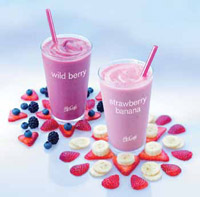Coming to Fruition
CONSUMER TRENDS
Although the majority of fresh and value-added fruit items grew in volume and dollar sales last year, the big news is that the recession has forced consumers to discover affordable and fabulous fruit options beyond the produce department, and they like what they are seeing. Sales of frozen fruits have already crossed the $700 million mark, according to The Nielsen Co. Canned fruit now ranks as the third-largest grocery category purchased by households headed by those ages 65+, reports Nielsen. In the mass market, excluding Wal-Mart, 2009 sales of trail mixes jumped 9%, and dry fruit snack sales were up 6%, according to SymphonyIRI Group data.
 Moreover, fruit and fruit juice are finding their way into a wide variety of foods. Fruit juice is replacing sweeteners in candies and gums, and fruit chips have moved mainstream, although at the same time, many consumers are reducing their consumption of fruit juice because of concerns about calories and/or sugar content.
Moreover, fruit and fruit juice are finding their way into a wide variety of foods. Fruit juice is replacing sweeteners in candies and gums, and fruit chips have moved mainstream, although at the same time, many consumers are reducing their consumption of fruit juice because of concerns about calories and/or sugar content.
There are new opportunities in the market for fresh fruit. Del Monte has introduced a produce vending machine, for example. Chiquita and Del Monte began selling single-wrap bananas in convenience stores such as Walgreens, and other drug stores have also increased the availability of fresh fruit “to go.”
Bananas, apples, grapes, strawberries, cantaloupe, watermelon, oranges, peaches, blueberries, and cherries top the list of fruits purchased by consumers in the past year, according to The Packer’s 2010 Fresh Trends Report. On the home front, 18% of consumers use apples as a side dish, 15% serve grapes as a side dish, and 12% do so with pears.
Bananas, apples, oranges, blueberries, strawberries, pomegranates, cranberries, grapefruit, avocados, and pineapples/peaches (in descending order) make up the top 10 list of fruits consumers perceive as most nutritious, reports the 2009 Gallup Study of Fruit.
Superfruits including açai, goji berry, mangosteen, and purslane were named by American Culinary Federation (ACF) chefs as the eleventh-hottest culinary trend for 2010 in the National Restaurant Assn.’s 2009 What’s Hot? survey. Watch for cloudberry, camu camu, golden kiwi, and quince, which are all gaining in popularity abroad, to become more popular in the U.S. marketplace as well. SPINS, a provider of natural products industry information, reports that superfruit sales totaled just under $300 million in conventional and natural channels for the year ended 1/23/10.
--- PAGE BREAK ---
Fruit and fruit juices have a bright future in restaurants, given their ability to add a health halo to foodservice fare. Quick-service (QSR) restaurant operators rank healthy options in kids’ meals as the No. 1 hot trend for fast food in 2010, and fruit side dishes come in at No. 20 on the list. Some operators are also mixing up creative kids’ juice drinks to offset slipping soda sales.
One in five QSR diners (22%) want more juices other than orange juice on the menu, according to Nation’s Restaurant News’ May 2010 Beverage Decisions report. Snacks and breakfasts—the two bright spots in the restaurant business—offer other big opportunities for fruit and fruit beverages. ACF chefs ranked fresh fruit items as the No. 3 breakfast menu trend for 2010; fresh fruit desserts were No. 7 on the list of hot dessert trends.
Expect chefs to use fruits to appeal to various demographic groups. More novel fruits such as Asian pears, kiwifruit, mangos, and avocados tend to attract younger diners; apricots, cantaloupe, honeydew, cranberries, and nectarines have greater appeal to older restaurant goers.
Marketers of juices and juice products need to pay careful attention to consumption behavior, however. More than one-third (37%) of consumers drank less juice this year than a year ago; consumption of orange juice has fallen 4% since 2005, according to Mintel’s Fruit Juice and Juice Drinks report.
Consumption of 100% fruit juice decreases with age. Those ages 18–24 were the top consumers of 100% fruit juice in 2009. Hispanics and African American consumers are among the heaviest consumers of juices and juice drinks, as are households with kids. Unfortunately, heavy users of 100% juice are among the most budget-constrained groups in the population and the most likely to opt for private-label products. Conversely, one in five older Baby Boomers, many of whom have higher-than-average discretionary income, and one-quarter of those age 65+ report never consuming juice products, which makes older consumers a very important missed target.
According to Mintel, price heads the list of purchase considerations for consumers of juices, juice drinks, and powdered drink mixes. Consumers also want products that are all natural and formulated with no additives, preservatives, or artificial colors. So it’s no surprise that Coke’s Minute Maid Simply Juices are a juice market sales leader.
Watch for juice slurries for kids in pocket packs, juices with added pulp and pieces to create a fresh-squeezed feel, and more products that deliver two or more servings of fruit. We’ll also be seeing new trends ranging from “no sulfur” dehydrated fruit snacks to the return of high-end, brandied, bottled fruits, chocolate-covered fruits, and specialty dried fruit confections.
by A. Elizabeth Sloan,
Contributing Editor
President, Sloan Trends Inc., Escondido, Calif.
[email protected]
